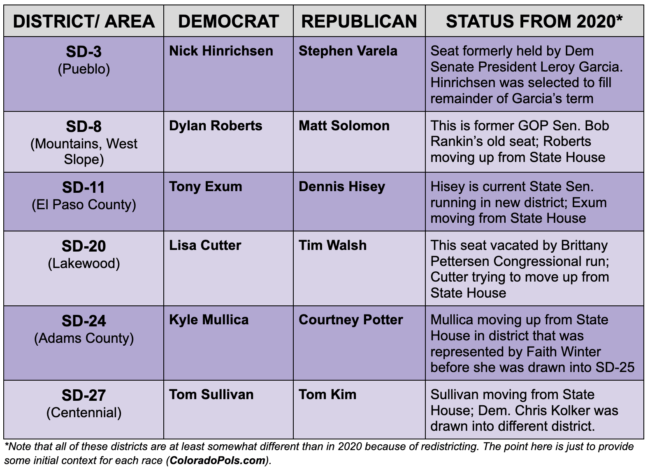
U.S. Senate
See Full Big Line
(D) J. Hickenlooper*
(R) Somebody
80%
20%

Governor
See Full Big Line
(D) Joe Neguse
(D) Phil Weiser
(D) Jena Griswold
60%
60%
40%↓

Att. General
See Full Big Line
(D) M. Dougherty
(D) Alexis King
(D) Brian Mason
40%
40%
30%

Sec. of State
See Full Big Line
(D) George Stern
(D) A. Gonzalez
(R) Sheri Davis
40%
40%
30%

State Treasurer
See Full Big Line
(D) Brianna Titone
(R) Kevin Grantham
(D) Jerry DiTullio
60%
30%
20%

CO-01 (Denver)
See Full Big Line
(D) Diana DeGette*
(R) Somebody
90%
2%

CO-02 (Boulder-ish)
See Full Big Line
(D) Joe Neguse*
(R) Somebody
90%
2%

CO-03 (West & Southern CO)
See Full Big Line
(R) Jeff Hurd*
(D) Somebody
80%
40%

CO-04 (Northeast-ish Colorado)
See Full Big Line
(R) Lauren Boebert*
(D) Somebody
90%
10%

CO-05 (Colorado Springs)
See Full Big Line
(R) Jeff Crank*
(D) Somebody
80%
20%

CO-06 (Aurora)
See Full Big Line
(D) Jason Crow*
(R) Somebody
90%
10%

CO-07 (Jefferson County)
See Full Big Line
(D) B. Pettersen*
(R) Somebody
90%
10%

CO-08 (Northern Colo.)
See Full Big Line
(R) Gabe Evans*
(D) Yadira Caraveo
(D) Joe Salazar
50%
40%
40%

State Senate Majority
See Full Big Line
DEMOCRATS
REPUBLICANS
80%
20%

State House Majority
See Full Big Line
DEMOCRATS
REPUBLICANS
95%
5%
 July 08, 2022 11:30 AM UTC
July 08, 2022 11:30 AM UTC 13 Comments
13 Comments

No. Rs need to win FOUR of those six to take control of the chamber. Seven returning members, plus B. Pelton, plus five safe R contested seats, plus Woodward's seat is 14. They need 18 to control the Senate.
Three pickup wins would make it an 18-17 advantage for Republicans.
With three pickups, they'd be at 17 (or tell me who I'm missing):
1. B. Pelton (SD-1)
2. Smallwood (SD-2)
3. Baisley (SD-4)
4. Rankin (SD-5)
5. Simpson (SD-6)
6. Rich (SD-7)
7. Lundeen (SD-9)
8. Liston (SD-10)
9. Gardner (SD-12)
10. Priola (SD-13)
11. Woodward (SD-15)
12. Kirkmeyer, or her replacement (SD-23)
13. Van Winkle (SD-30)
14. R. Pelton (SD-35)
…plus three pickups gets them to 17. They need four to get to 18.
The confusion might be because Dennis Hisey currently represents SD2, but was drawn into SD11, where he is running against Tony Exum. Ballotpedia lists him as an incumbent, since he is a sitting State Senator, and the seat is open. That is Repub seat number 15.
Right, but the seat he's running for this year is competitive and listed in Pols' table in the OP. Counting his seat as an incumbent hold and as a pickup opportunity would be counting it twice. Rs need to win four of the six races listed in the table to control the Senate.
You're kind of right. Scrambling the districts is screwing with the math.
Since I have a hard time imagining how Republicans will pull off upsets of Polis, Bennet, or any of the incumbent House members, and all of those races will have campaign money, is there any indication of a strategy of trying to lengthen the coattails of those at the top of the ballot and improve chances of downballot wins? Seems like Senate and House races that are, in any sense, "competitive" would benefit from some targeted registration, GOTV, and holding events in those contested areas.
I have been out of statewide politics just long enough to not really know the players anymore. But based on the districts, I only see 5 worth watching:
SD11: Currently DEM: but now has all that eastern Springs. I'm guessing this one goes GOP. Hisey will be replaced by a vacancy committee so his old district (not up this year) remains GOP as well.
SD20: Currently DEM, but has some big GOP pockets. Has that changed?
SD24: Currently DEM. I have a hard time getting a feel for western Adams these days. How competitive is this one considered?
SD25: Currently GOP but redistricting gives incumbent advantage to DEM. Traditionally a toss-up area.
CD30: Currently GOP Might be wrong on this one but it seems new district should be bluer than old was and it's open, so maybe DEM pick-up?
The rest look like fairly foregone conclusions to me. Am I wrong?
SD15 now includes a lot of west Boulder County which makes it more competitive–close to 50/50. It'll be Marchman's turnout against Woodward's personal fortune. If you live in a safe seat district, you know what to do!
The redistricting committee found it to be dead even based on ele3ction results from 8 races. Voter registration gives Rs a 2% advantage, but the Unaffiliated and Other Party votes make up 46% of the electorate so not sure how much R vs D numbers matter.
I'm in SD 8 and have met Dylan Roberts a couple of times. He comes across as the real deal and is campaigning hard in a BIG district (10 counties from the Front Range to the Utah border). Go Dylan.
Yes, Dylan's good. SD8 has probably improved for Dems (I have not looked closely at the numbers) but it is still a very challenging District with many hours of driving to get to all the communities.
Actually looking at the numbers it does actually slightly favor Dems.
Voter Reg: 27% R 25% D 46% U 2% other
Elections results used by the redistricting commission: overall 6.6% lean in favor of Ds
These number are easily found for all legislative and congressional districts at: https://redistricting.colorado.gov/content/2021-final-maps